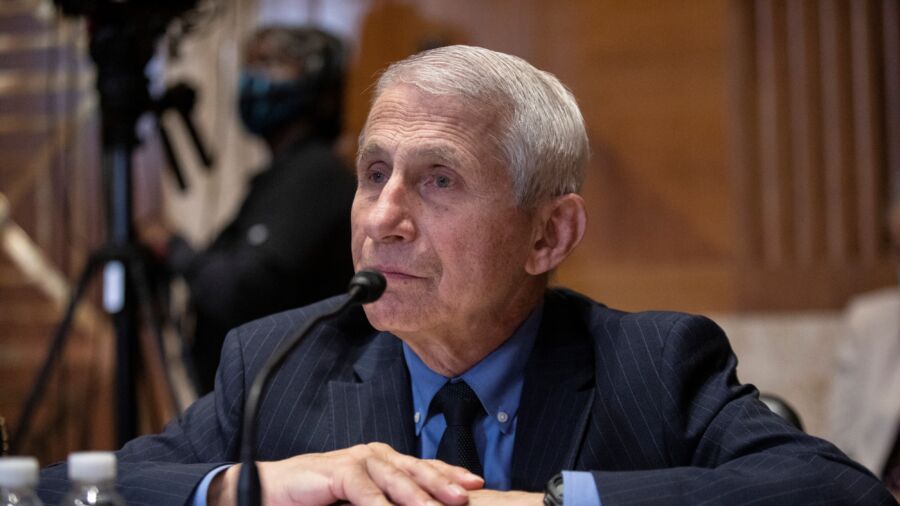The National Institute of Health (NIH) received approximately $325 million in royalty payments over a 12-year span from pharmaceutical companies and research organizations, according to new documents obtained by nonprofit government transparency organization Open The Books.
Open The Books received records detailing more than 56,000 royalty payments to NIH members Freedom of Information Act (FOIA) between 2009 and 2021.
The government watchdog organization has been seeking these NIH royalty payment records for nearly two years, as part of a series of FOIA requests. The NIH has fought the document disclosure requests and these documents came through new productions in a Washington D.C. federal court case (pdf).
Last year, Open The Books estimated the NIH received as much as $350 million in royalty payments between 2009 and 2020. The organization revised that figure downward as the NIH provided new details about its royalty payments.
Open The Books is continuing to evaluate NIH document productions and question continued redactions by the public health agency. The NIH initially fought to withhold the names of those entities making royalty payments and their recipients. Detailing the prior $350 million estimate, Open The Books CEO Adam Andrzejewski explained that “since the NIH documents are heavily redacted, we can only see how many payments each scientist received, and, separately, the aggregate dollars per NIH agency.”
“This is a gatekeeping at odds with the spirit and perhaps the letter of open-records laws,” Mr. Andrzejewski added.
NTD News reached out to the NIH for comment, but did not receive a response by the time this article was published.
Fauci, Collins Received Dozens of Royalty Payments
Among the recipients of royalty payments between 2009 and 2020 were then-NIH Director Francis Collins and then-National Institute of Allergy and Infectious Diseases (NIAID) Director Anthony Fauci. NIAID is an NIH component.
The records include 37 royalty payments entries to Dr. Fauci from Ancell Corporation, Chiron Corporation, and Santa Cruz Biotechnology Inc.
There were 21 entries for Mr. Collins, from GeneDx, Inc., IONIS, ISIS Pharmaceuticals, Inc., the Progeria Research Foundation, and Specialty Laboratories, Inc.
In a May 2022 House hearing, Rep. John Moolenaar (R-Mich.) asked Acting BIH Director Lawrence Tabak whether he believed these royalty payments could create the appearance of a conflict of interest. Mr. Tabak insisted there are appropriate separations of power in place, including a policy that NIH members who receive royalty payments for contributing to products or innovations cannot also be in a position to recommend those products or innovations as treatments down the line. Still, Mr. Moolenaar raised concerns about NIH officials working to one another’s benefit.
“You’ve had leaders of NIH saying certain medicines are not good, based upon the clinical trials that were supported by the agency but if the agency is awarding who the beneficiary of the grant who’s doing the trial, and there are somehow finances involved then there’s a financial benefit that could be accrued if someone’s, you know, patent or invention is considered valid,” Mr. Moolenaar said. “Do you not see that as a conflict or an appearance of a conflict of interest.”
“I certainly can understand that it might seem as an appearance,” Mr. Tabak replied. Still, the NIH head insisted NIH members who contribute to scientific developments and receive royalty payments are not allowed to also have a decision-making role to recommend those same products as treatments.
In a June 2022 Senate hearing, Sen. Rand Paul (R-Ky.) asked Dr. Fauci if the NIAID director had ever received a royalty from any entity to which he oversaw the distribution of money in research grants. Mr. Fauci replied, “I don’t know as a fact, but I doubt it.”
The new royalty payment data could contradict Dr. Fauci’s response to Dr. Paul. Dr. Fauci served as the director of NIAID between 1984 and the end of 2022. In 2004, while NIAID contracted with Chiron to research and develop a vaccine against avian influenza. While the FOIA production doesn’t show precise dollar amounts, it indicates Dr. Fauci took eight royalty payments from Chiron between 2010 and 2014.
Mr. Andrzejewski said Mr. Tabak and Dr. Fauci’s representations to Congress “were misleading, if not outright false.”
Royalties From Russia and a Wuhan Lab Connection
Among the data obtained by Open The Books, there were 20 royalty payment entries from the Joint-Stock Company, Pokrov Biologistics Plant, a Russian bio-research firm. While ostensibly working to develop vaccines for farm animals, the Pokrov Bio Plant has been accused of developing biological weapons for the Soviet Union, transforming common livestock maladies into weapons of war. In a 2002 report by The Washington Post, Pokrov’s plant director at the time, Vladimir Gavrilov, acknowledged the plant included bunkers for housing “very dangerous pathogens.”
Other royalty payments came from at least 28 Chinese companies, including 68 payments from the Wuhan Institute of Biological Products Co Ltd. The NIH took 14 payments from the Wuhan Institute of Biological Products Co. Ltd. between 2017 and the end of 2020, according to the data.
The Wuhan Institute of Biological Products Co. Ltd. is an affiliate of the Chinese state-owned pharmaceutical company Sinopharm, which developed a COVID-19 vaccine for the Chinese market.
The Wuhan Institute of Biological Products Co. Ltd. has partnered with the Wuhan Institute of Virology, including on COVID-19 vaccine research. The Wuhan Institute of Virology has been a point of focus in the United States amid allegations that the COVID-19 outbreak leaked from the lab.
“We now finally have a glimpse of where the money is coming from, and it only reinforces our reasons for working so hard to uncover the records,” Mr. Andrzejewski said in an emailed statement to NTD News. “Medical innovations funded by the American taxpayer are being licensed and utilized by companies in adversarial nations like China, Russia, and Belarus. At least one was allegedly a front for Soviet bioweapons research. Another moved down the street from the Wuhan Institute of Virology to cooperate with them on projects.”

